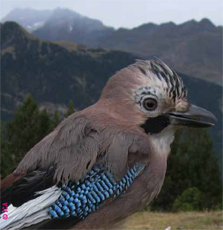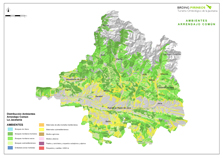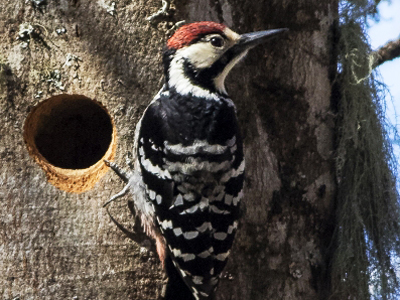Searching Birdingpirineos.com
BIRDS, ECOSYSTEMS and BEST SEASONS
Define search criteria: birds, ecosystems or seasons and consult the Birding Pyrenees database.
Eurasian Jay
Ecosystems: GRASSLANDS, MEADOWS AND FARMLAND
Seasons: January | February | March | April | May | June | July | August | September | October | November | December |


SCIENTIFIC NAME: Garrulus glandarius
FAMILY: Corvidae
DESCRIPTION: This attractive bird belongs to the family of crows and is well adapted to the forest. The bird has a pinkish brown plumage, with a black moustachial stripe, wings and tail in black and white and a striking turquoise blue on its shoulders, which is only visible at close quarters. The Jay acts as the voice of alarm in the forest, emitting a harsh, rasping screech warning of any predator it sees, including human beings.
STATUS IN ARAGON: R Nr (Resident - Breeds regularly)
BREEDING PROBABILTY: Breeding highly likely
REPRODUCTIVE: Yes
LOCAL STATUS: Resident
MONTHS: All
ECOSYSTEMS: Forest - Pastures, meadows and crops - Riverside.
DIET AND FEEDING: From March to September its diet is primarily composed of insects and is supplemented with the eggs and chicks of other species. Throughout the rest of the year, the Jay eats chestnuts, acorns and wild roses. If it approaches urban areas it usually feeds on the organic waste left at waste dumps.
HABITS: In autumn it usually buries acorns, nuts and beechnuts for use as a larder during the winter. This habit contributes to the expansion of woodland areas.
THREAT OF EXTINCTION + CRITERION: CNEA (National Catalogue of Endangered Species): Not included CREA: Not included
ROUTES: 1 (Zuriza - River Veral), 2 (Linza – Gamueta woodland ) and 6 (Garcipollera Valley)
SPATIAL DISTRIBUTION: Mediterranean scrubland, open cultivated land and pastures, subalpine and alpine rock faces and stony outcrops.




